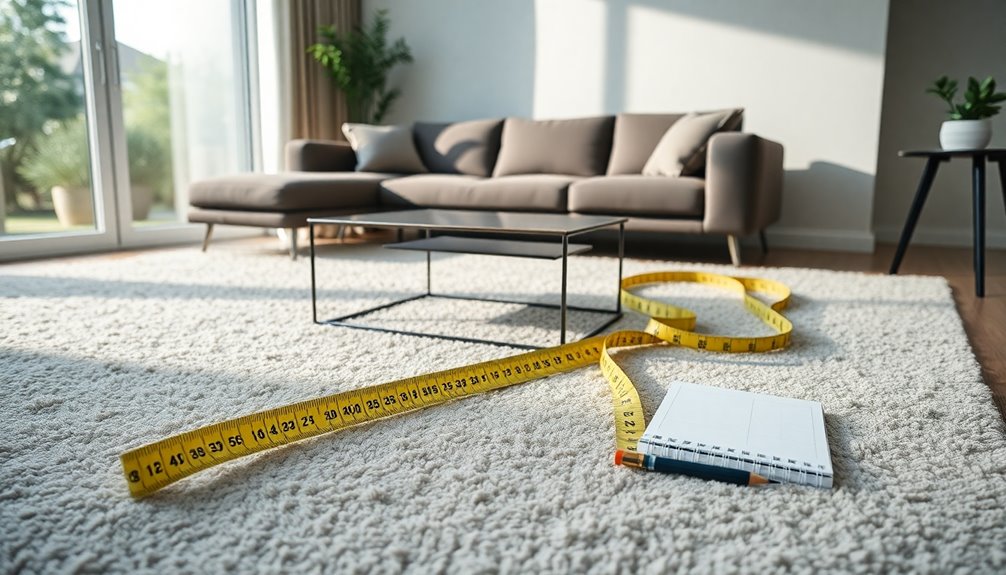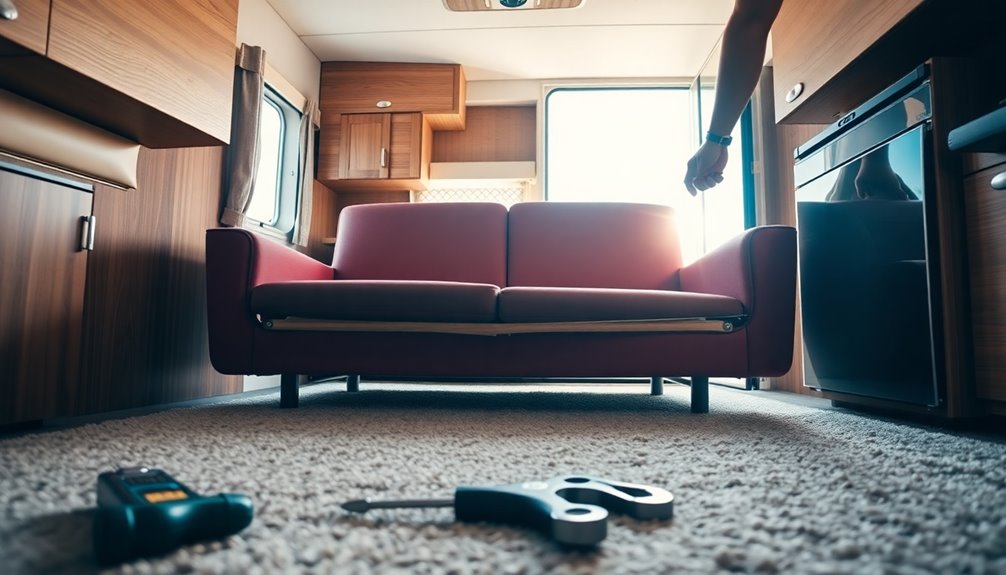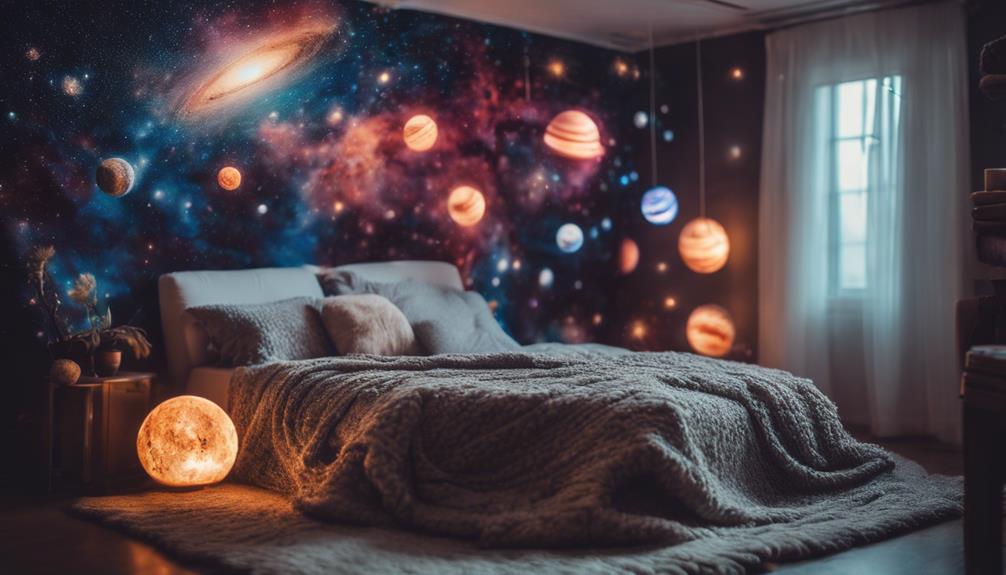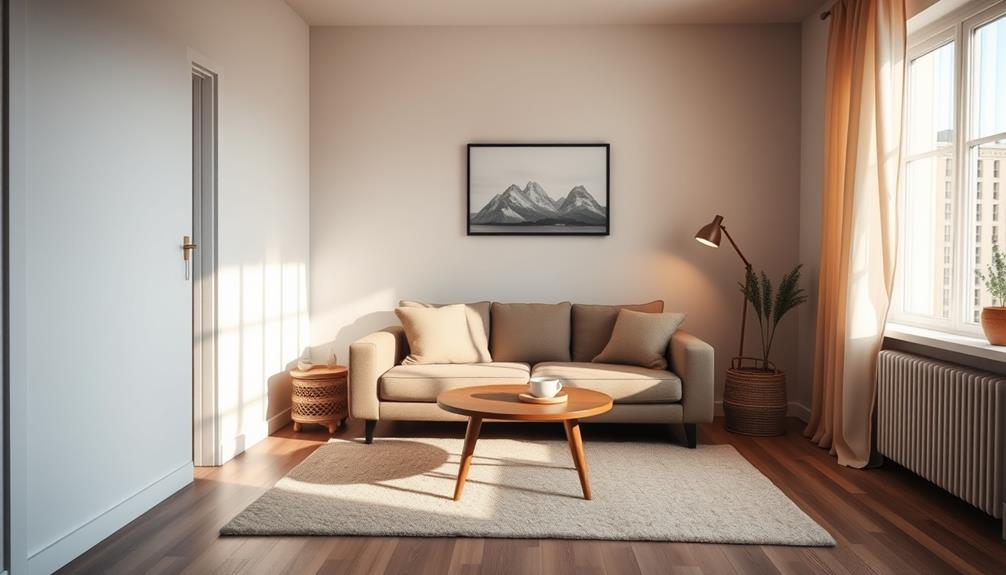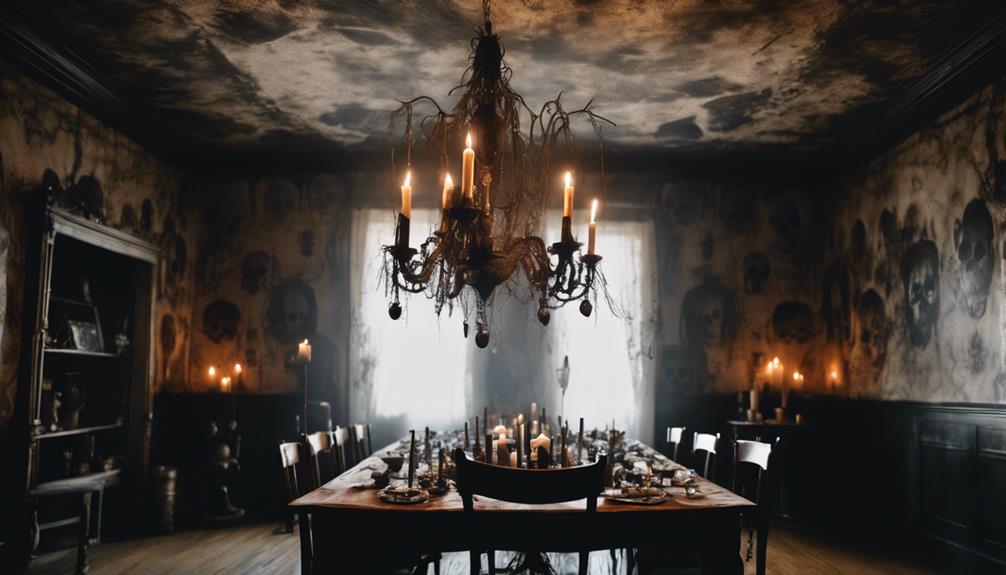To measure furniture dimensions, grab a tape measure for the best results. First, measure the width from left to right, then the height from the floor to the highest point, and lastly, the depth from front to back. Don't forget to account for any protruding parts, like armrests. If you're dealing with irregular shapes, use the tick sticking method. It's also smart to check doorways and pathways to ensure easy delivery. Relying on consistent measurement standards will help maintain clarity. Stick around, and you'll discover more tips for achieving accurate and effective measurements.
Key Takeaways
- Use a tape measure to obtain width (W), height (H), and depth (D) of furniture for accurate fitting and placement.
- Measure diagonal dimensions to ensure furniture can maneuver through entry points and tight spaces.
- Record measurements consistently in the format of width, height, and depth to avoid confusion during delivery.
- Check room dimensions against furniture measurements to ensure compatibility and optimal layout.
- Consider obstacles like doorways and fixed objects when planning the delivery path for the furniture.
Essential Measuring Tools
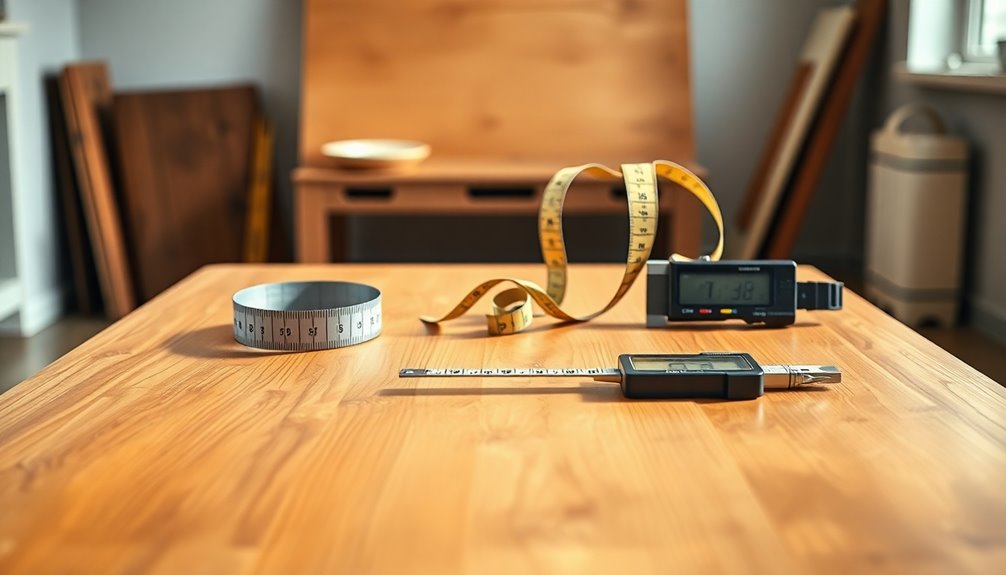
When measuring furniture dimensions, having the right tools is essential for accuracy. Start with a tape measure, which helps you determine the width, depth, and height of your furniture. Look for one with clear markings and a strong locking mechanism. A 16-foot tape measure is usually enough, but consider a longer one for larger projects. A magnetic hook can be handy when working with metallic materials.
Next, use stainless steel rulers for short distances and to ensure straight edges. A non-slip backing will help it stay in place during use. Rulers are also great for checking if your furniture will fit through doorways and hallways.
Don't forget squares and combination squares. They'll help you check angles and ensure your cuts are accurate. A combination square can also serve multiple functions, like marking straight lines. Additionally, a combination square is perfect for marking 90° and 45° angles, enhancing your precision in joint setups.
Finally, consider digital tools for precision. Laser measuring devices offer quick measurements, while digital calipers can provide exact measurements down to fractions of a millimeter. Level tools are vital for confirming that your furniture sits correctly in your space. With these essential tools, you're ready to measure accurately.
Key Dimensions to Measure
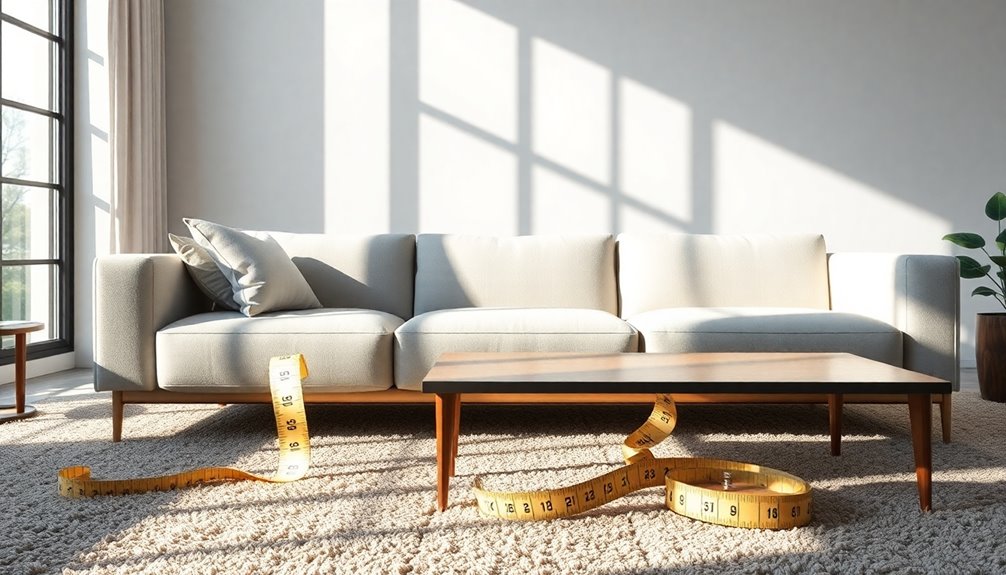
To ensure your furniture fits perfectly in your space, it's crucial to measure key dimensions accurately. Start with the width (W), which you measure from left to right while facing the front of the furniture. Don't forget to include the widest parts, like armrests on sofas. This measurement is vital for determining if the furniture can fit through doorways and hallways.
Next, measure the height (H), from the floor to the highest point of the furniture. Make sure to account for permanent components like the back frame but exclude pillows unless specified. This helps you confirm the furniture fits in your room and can be moved through entry points. Using a metal tape measure ensures you get accurate height measurements.
Lastly, measure the depth (D) from the front to the back. Include the deepest part, such as the back of a sofa, as this is crucial for navigating through tight spaces and planning your room's layout.
For specific pieces, you might also consider diagonal measurements, which help evaluate whether the furniture can maneuver through entry points. Taking these key dimensions will help ensure a smooth delivery and perfect placement in your space.
Techniques for Complex Furniture
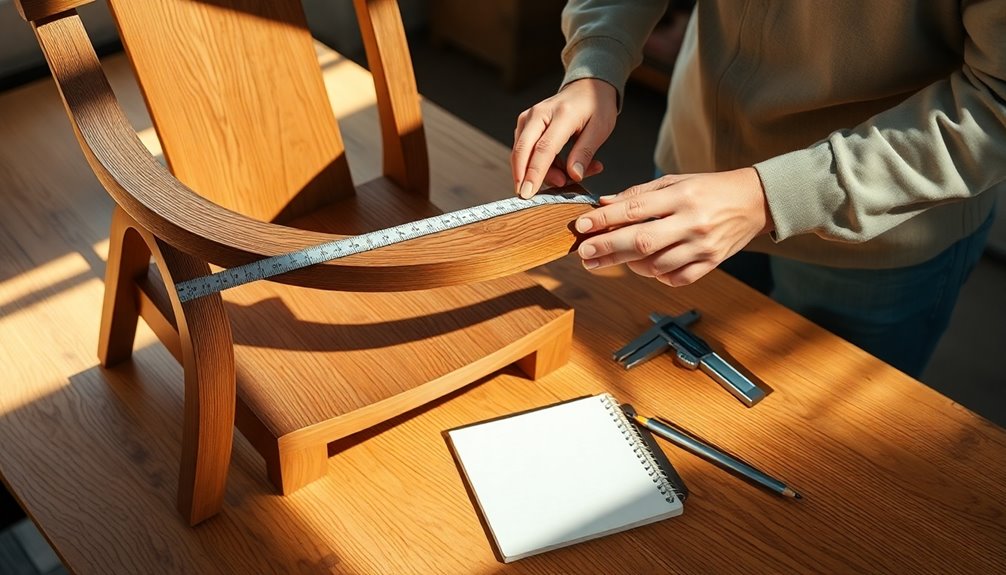
Measuring complex furniture requires some specific techniques to ensure a perfect fit in your space. Start by measuring diagonal dimensions, which are crucial for navigating through doorways and hallways. Use a straight edge ruler to measure from the highest back point of sofas or sectionals to the front of the arm. This helps assess any entry challenges and guarantees smooth delivery. Additionally, consider employing the tick sticking method for accurate measurements when dealing with irregularly shaped furniture pieces.
Next, consider using advanced measuring tools like laser devices. These tools provide quick and precise measurements, especially over larger distances or in tight spaces. They're invaluable for larger furniture items, and you can combine them with traditional tape measures for thoroughness. Just make sure the laser device is calibrated correctly.
Don't forget to account for obstacles and pathways. Measure the width and diagonal height of hallways and doorways that the furniture must pass through. Note any corners or fixed obstacles like light fixtures that could interfere with placement. Finally, visualize furniture placement by sketching the room's layout on graph paper or using a true-to-size footprint with paper, ensuring everything fits perfectly in the intended space.
Industry Measurement Standards
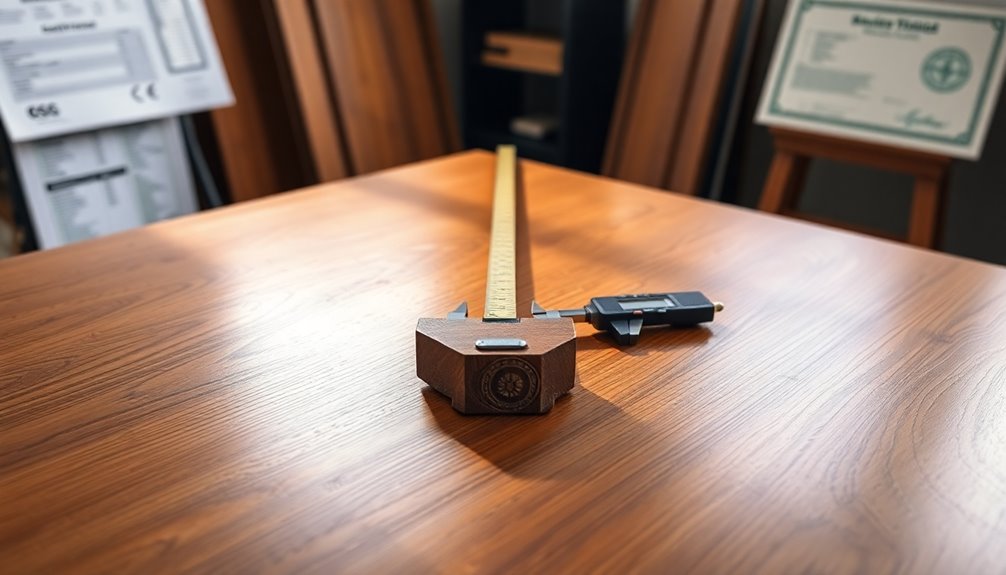
Furniture dimensions follow specific industry standards that help ensure consistency and clarity in communication. When you measure furniture, remember to follow the order of width, height, and depth. Start by measuring from left to right for width, from the floor to the top for height, and from front to back for depth. This standard makes it easier for everyone to understand the dimensions.
For common furniture, know the key dimensions: a dining table is typically 29 inches high, 40 inches wide, and 64 inches long. A dining chair usually measures 19 inches wide, 19 inches deep, with a seat height of 18 inches and an overall height of 36 inches. Dressers and chests generally follow a similar pattern, while mattresses are measured by width, length, and height. Additionally, for standard mattress dimensions, twin mattresses measure 38 inches by 75 inches.
Don't forget to measure entry points like doorways and hallways to ensure your furniture can fit through. Use a metal tape measure for precision and record your measurements in a height (H), width (W), and length (L) format. This preparation helps you avoid delivery issues and ensures your new furniture fits perfectly in your space.
Tools for Specific Tasks
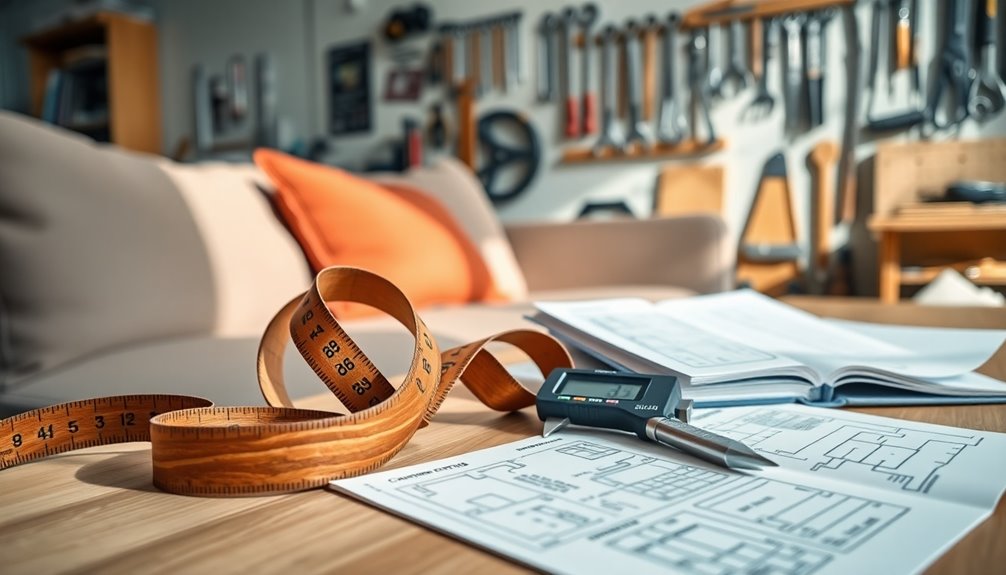
When tackling furniture dimensions, having the right tools can make all the difference. For basic measurements, a tape measure is essential. Choose one that's flexible and durable, ideally with both imperial and metric markings. It's your go-to for measuring width, depth, and height.
When you need to tackle more complex measurements, a straight edge ruler becomes invaluable, especially for diagonal dimensions. This tool helps you assess if furniture can fit through entry points or tight spots accurately.
For larger items and tight spaces, laser measuring devices are a game changer. They provide quick, precise measurements, reducing manual effort and improving accuracy. Some smartphones even come equipped with built-in laser measuring features.
Don't forget to record your measurements accurately. A pencil and paper are crucial for jotting down dimensions for future reference. You might also want to use a level tool to ensure your furniture sits correctly in its designated space. For finer measurements, like thicknesses, digital calipers offer high precision, cutting down on human error. Lastly, smartphone apps can aid in measuring and converting units, making your task even easier.
Best Practices for Accuracy
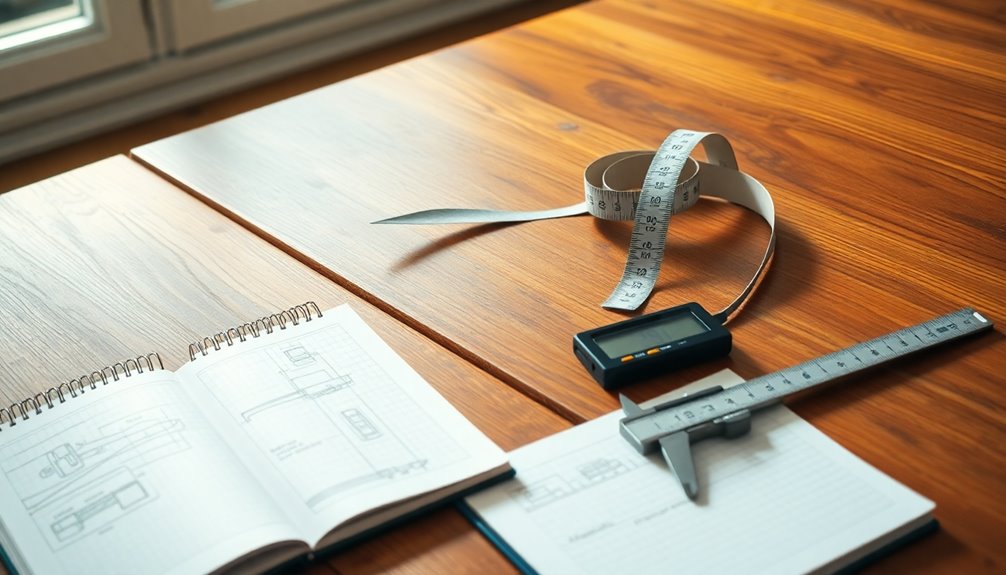
Achieving accurate measurements is crucial to ensuring your furniture fits perfectly in your space. Start by measuring the furniture itself. For width, measure from arm to arm, focusing on the widest points. When measuring height, ignore removable pillows or cushions and capture the highest to lowest points. For depth, measure from the front of the seat to the back, and don't forget to check the diagonal depth for tight spaces.
Next, measure your entry points. Capture the width, height, and diagonal distance of doorways, hallways, and stairwells. Consider removing doors for extra space and take note of any obstacles like ceiling fans and banisters. Ensure you leave at least 4 inches of clearance for maneuverability. Accurate room dimensions are essential for selecting appropriate furniture size and placement.
Finally, compare the furniture dimensions with the measurements of your room and pathways. Visualize placement using sketches or life-size footprints on the floor. Be meticulous about accounting for obstacles, including light fixtures and wall art, that may impede placement. Always consider the total dimensions, including legs and bases, and plan the optimal pathway from delivery to placement. These best practices will help you navigate potential challenges seamlessly.
Recording and Verifying Measurements
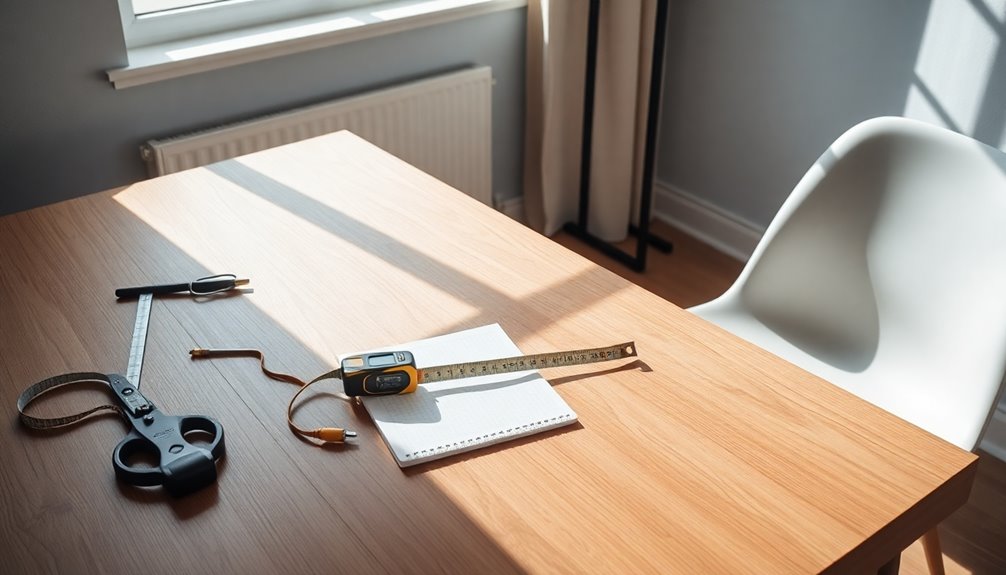
Accurate recording and verification of your measurements are essential to ensure everything fits as intended. Start by measuring the height (H), width (W), and depth (D) of your furniture, including any extended features like arms or cushions. Don't forget to document diagonal measurements, especially for items like sofas and bookcases, as they're crucial for tight spaces.
Next, ensure you compare these measurements against your room's dimensions. Check doorways, hallways, and stairwells to confirm the furniture can pass through the narrowest entry points. Make sure to account for any immovable objects like light fixtures or railings that could impact the placement. Accurate measurements enhance the overall aesthetic and functionality of the space, ensuring a harmonious integration of new furniture.
As you record, keep everything organized. Write down your measurements in a safe, easily accessible spot, and consider using graph paper or scaled footprints to visualize the space. This helps you see how your furniture will fit within the room's layout. Finally, double-check each measurement to eliminate errors. A small mistake can lead to significant issues during delivery or setup, so take your time to verify and ensure accuracy.
Frequently Asked Questions
How Do I Measure Furniture for Small Spaces?
To measure furniture for small spaces, start by determining the dimensions of the area where you plan to place the furniture. Use a tape measure to check the width, depth, and height. Don't forget to account for doorways and narrow hallways. Consider diagonal measurements for tight corners, too. Visualize how the furniture will fit by sketching or using graph paper, ensuring you leave enough space for movement and accessibility.
Can I Use My Smartphone for Measuring Furniture Dimensions?
Yes, you can definitely use your smartphone for measuring furniture dimensions! With various AR apps available, you can easily get accurate measurements without traditional tools. Apps like MeasureKit and Quick Measure let you take quick measurements by simply pointing your camera at the object. They often allow you to switch between units and even save photos with measurements for later reference. It's an efficient and convenient way to measure your space!
What Should I Do if My Furniture Has an Irregular Shape?
If your furniture has an irregular shape, start by identifying its key dimensions like the longest side and height. Break it down into simpler shapes, measuring each part carefully. Use specialized tools like a bevel gauge for angles and a laser level for accuracy. Don’t forget to account for any extended features and visualize how it’ll fit in your space. Double-check everything to ensure it’ll navigate through tight spots without issues. Once you have all your measurements, it can be helpful to research similar pieces that match your style and dimensions. This is especially useful if you’re considering alternative options or want to explore budget-friendly choices. Look up guides on how to locate furniture dupes, ensuring that you can find affordable replicas that maintain the aesthetic you’re aiming for. Moreover, remember to factor in the material and color to achieve a cohesive look in your space.
How Do I Measure Furniture to Fit Around Obstacles?
To measure furniture to fit around obstacles, start by identifying any barriers in the path, like walls or furniture. Then, measure the distance from the obstacle to the intended placement area. Use a tape measure to check the width and height of both the furniture and the obstacles. Don't forget to account for any angles or turns your furniture will need to navigate. This'll help ensure a smooth fit without any surprises.
Are There Apps Available for Furniture Measurement?
Yes, there are several apps that can help you measure furniture accurately. Apps like AR Plan 3D and MeasureKit use augmented reality to provide virtual measurements right in your space. You can create floor plans, visualize in 3D, and even convert units easily. With features like automatic scans and manual adjustments, you'll find it easier to ensure your furniture fits perfectly. Just remember, some apps may have limitations with accuracy in certain situations.
Conclusion
Measuring furniture dimensions accurately is crucial for ensuring everything fits perfectly in your space. By using the right tools and techniques, you can avoid costly mistakes and make informed decisions. Remember to double-check your measurements and follow industry standards for best results. With these practices in mind, you're well-equipped to tackle any furniture project with confidence. Happy measuring, and enjoy creating a space that reflects your style and needs!
